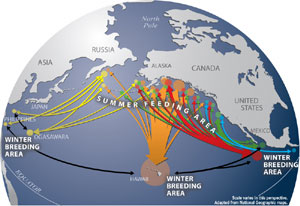 | |||||||||||
|
|
|
|
|

Known as SPLASH, the Structure of Populations, Levels of Abundance and Status of Humpbacks project is an international cooperative research effort to provide a better understanding of humpback whale populations throughout the North Pacific. Since the project began in 2004, SPLASH researchers have collected an unprecedented amount of data, including photographs of the unique patterns on the underside of humpbacks’ tail flukes, and small skin biopsies for use in genetic analysis and other tests. “NOAA is proud to be a major participant in and supporter of the world’s largest whale study, the SPLASH Project,” Lautenbacher said. “Using NOAA ships and small boats, as well as a variety of vessels as diverse as Canadian Coast Guard ships and Philippine outrigger canoes, SPLASH researchers collected data about North Pacific humpback whales in all known feeding and breeding habitats between winter 2004 and winter 2006.”
“Analysis of the movement data indicates that there is a ‘missing’ humpback breeding ground, the location of which is currently unknown, used primarily by whales from the Bering Sea and the Aleutians,” Calambokidis explained. “Based on the data collected by SPLASH, this missing area is most likely located between Asia and Hawaii.” A map created by SPLASH researchers summarizes the whale movements documented over two winters and one summer. The width of the arrows on the map represents the relative number of individuals documented to have moved between the connected breeding and feeding grounds, and the arrows are color coded to correspond with the five suspected breeding grounds. The black lines represent the relatively small number of individuals that travel to different breeding grounds from one winter to the next. The humpback whale migrates farther than any other mammal on Earth, feeding in high latitudes and traveling as far as 4,000 miles to tropical breeding grounds. With ranges that can span entire ocean basins, it provides an iconic example of the challenge of understanding and managing highly mobile marine mammals. The SPLASH project is the product of extensive cooperation between NOAA scientists and over 50 organizations worldwide. According to David Mattila, research coordinator for NOAA’s Hawaiian Islands Humpback Whale National Marine Sanctuary, “SPLASH could not have been accomplished without the incredible dedication of over 300 researchers from 10 countries." |
|
||||||
|
|||||||||||






